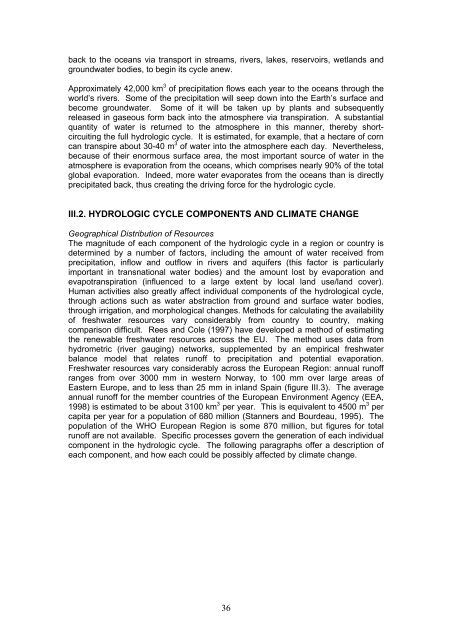Climate Change and the European Water Dimension - Agri ...
Climate Change and the European Water Dimension - Agri ...
Climate Change and the European Water Dimension - Agri ...
You also want an ePaper? Increase the reach of your titles
YUMPU automatically turns print PDFs into web optimized ePapers that Google loves.
ack to <strong>the</strong> oceans via transport in streams, rivers, lakes, reservoirs, wetl<strong>and</strong>s <strong>and</strong><br />
groundwater bodies, to begin its cycle anew.<br />
Approximately 42,000 km 3 of precipitation flows each year to <strong>the</strong> oceans through <strong>the</strong><br />
world’s rivers. Some of <strong>the</strong> precipitation will seep down into <strong>the</strong> Earth’s surface <strong>and</strong><br />
become groundwater. Some of it will be taken up by plants <strong>and</strong> subsequently<br />
released in gaseous form back into <strong>the</strong> atmosphere via transpiration. A substantial<br />
quantity of water is returned to <strong>the</strong> atmosphere in this manner, <strong>the</strong>reby shortcircuiting<br />
<strong>the</strong> full hydrologic cycle. It is estimated, for example, that a hectare of corn<br />
can transpire about 30-40 m 3 of water into <strong>the</strong> atmosphere each day. Never<strong>the</strong>less,<br />
because of <strong>the</strong>ir enormous surface area, <strong>the</strong> most important source of water in <strong>the</strong><br />
atmosphere is evaporation from <strong>the</strong> oceans, which comprises nearly 90% of <strong>the</strong> total<br />
global evaporation. Indeed, more water evaporates from <strong>the</strong> oceans than is directly<br />
precipitated back, thus creating <strong>the</strong> driving force for <strong>the</strong> hydrologic cycle.<br />
III.2. HYDROLOGIC CYCLE COMPONENTS AND CLIMATE CHANGE<br />
Geographical Distribution of Resources<br />
The magnitude of each component of <strong>the</strong> hydrologic cycle in a region or country is<br />
determined by a number of factors, including <strong>the</strong> amount of water received from<br />
precipitation, inflow <strong>and</strong> outflow in rivers <strong>and</strong> aquifers (this factor is particularly<br />
important in transnational water bodies) <strong>and</strong> <strong>the</strong> amount lost by evaporation <strong>and</strong><br />
evapotranspiration (influenced to a large extent by local l<strong>and</strong> use/l<strong>and</strong> cover).<br />
Human activities also greatly affect individual components of <strong>the</strong> hydrological cycle,<br />
through actions such as water abstraction from ground <strong>and</strong> surface water bodies,<br />
through irrigation, <strong>and</strong> morphological changes. Methods for calculating <strong>the</strong> availability<br />
of freshwater resources vary considerably from country to country, making<br />
comparison difficult. Rees <strong>and</strong> Cole (1997) have developed a method of estimating<br />
<strong>the</strong> renewable freshwater resources across <strong>the</strong> EU. The method uses data from<br />
hydrometric (river gauging) networks, supplemented by an empirical freshwater<br />
balance model that relates runoff to precipitation <strong>and</strong> potential evaporation.<br />
Freshwater resources vary considerably across <strong>the</strong> <strong>European</strong> Region: annual runoff<br />
ranges from over 3000 mm in western Norway, to 100 mm over large areas of<br />
Eastern Europe, <strong>and</strong> to less than 25 mm in inl<strong>and</strong> Spain (figure III.3). The average<br />
annual runoff for <strong>the</strong> member countries of <strong>the</strong> <strong>European</strong> Environment Agency (EEA,<br />
1998) is estimated to be about 3100 km 3 per year. This is equivalent to 4500 m 3 per<br />
capita per year for a population of 680 million (Stanners <strong>and</strong> Bourdeau, 1995). The<br />
population of <strong>the</strong> WHO <strong>European</strong> Region is some 870 million, but figures for total<br />
runoff are not available. Specific processes govern <strong>the</strong> generation of each individual<br />
component in <strong>the</strong> hydrologic cycle. The following paragraphs offer a description of<br />
each component, <strong>and</strong> how each could be possibly affected by climate change.<br />
36













